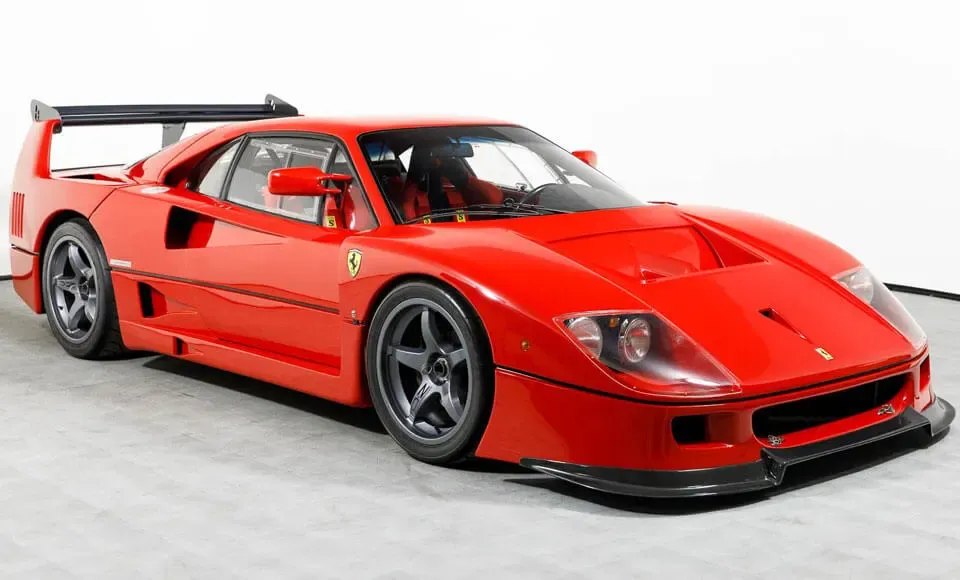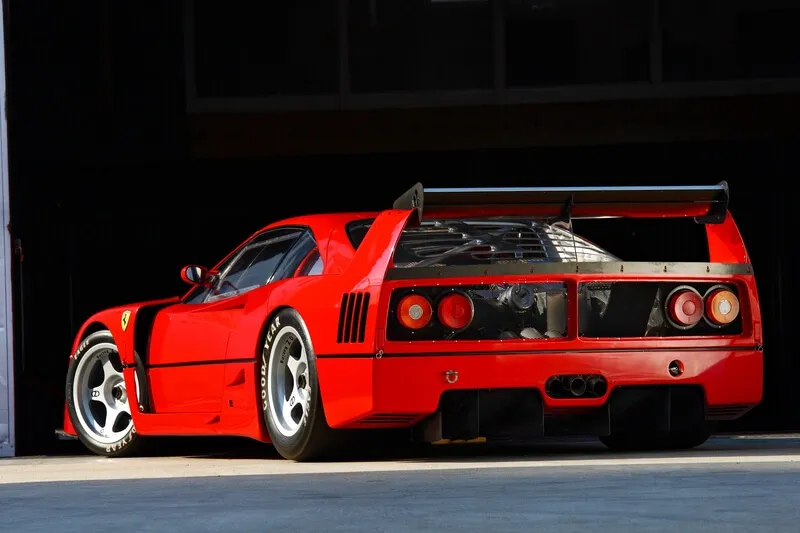The biggest hurdle of starting a blog about your passion is getting an answer on the question ‘where do I start?’. There are literally thousands of car-related topics I could write about. But if I go back to my childhood to find out where my passion for cars started, I have to go way back. My first memory of cars is of me controlling a little R/C Ferrari F40 on the school ground after the school was closed. I don’t know exactly what it is that drew this young boy’s attention, but the Ferrari F40 certainly has something magic. And let’s be honest, that Rosso Corsa just looks stunning.
A while ago somebody asked me about my absolute favorite car. My ‘Holy Grail’. Without any doubt, I answered: a Ferrari F40. So there I have it: my very first topic for Retrolista, my blog about my passion for (vintage) supercars. So let’s dive into the story of this beautiful machine.
Table of Contents
Introduction
The Ferrari F40 is widely regarded as one of the most iconic and legendary supercars of all time. It was built to celebrate Ferrari’s 40th anniversary, and it quickly became a symbol of speed, power, and style. The F40 was designed by Pininfarina and engineered by Nicola Materazzi, and it was built from 1987 until 1992.
The F40 was not just a car, it was a (bold) statement. It was also the Ferrari personally approved by Enzo Ferrari, and he wanted it to be a statement piece. He insisted that it should be raw, intimidating, and above all, fast.
But the true idea behind the car is that Ferrari would build a race car that is road-legal and that it could compete with another legend: the Porsche 959. In the mid-1980s, the motoring world was filled with excitement as Ferrari and Porsche went head-to-head to produce the world’s fastest road car. Porsche had pulled ahead with the 959, and Ferrari needed a successor to the 288 GTO that could outperform its German competitor. The F40 was that successor.
As said for me, the Ferrari F40 is the absolute ‘Holy Grail’ of supercars. And I believe that many car enthusiasts would agree. It is a car that represents the pinnacle of automotive engineering and design, and it is a car that continues to capture the imagination of people around the world. Whether you are a fan of speed, power, or style, the Ferrari F40 is a car that is sure to leave you speechless.

Impact
The F40 was a boundary-pushing marvel that transformed the supercar landscape forever. It shattered expectations of what a road car could do, breaking the 200 mph barrier when many were just coming to get used of the idea of a 150mph car. More importantly, it did without the advanced electronics and driver aids that characterize today’s cars. This has endeared the F40 to enthusiasts who yearn for a raw and pure driving experience unfiltered by electronic intervention.
The F40 also marked the end of an era for Ferrari, with its successors becoming increasingly sophisticated and electronically assisted. Despite this, or perhaps because of it, the F40’s raw, unadulterated nature has made it a coveted classic. While this car really was built for riding (and riding hard!), experts believe that only 10% of all F40s that left the factory were actually used for driving. It became an object for speculators and collectors, leaving so much technology unused.
Technology & design
The F40 was built mainly from composites, and it featured a sophisticated high-performance, turbo-charged running gear combined with a first-class chassis that gave it the kind of great dynamic prowess that was close to that of a racing car. The F40 was not just a car, it was a work of art. The car’s design was heavily influenced by the Ferrari 288 GTO, which was a limited edition model built for Group B racing. Its striking, aggressive lines and signature rear wing created an image that captivated a generation of car enthusiasts. The car’s design left no one indifferent, with its wide, low stance, NACA ducts, and a rear dominated by cooling grills and high wing. It looked as close to a race car as a road car could get.
The F40 featured a mid-mounted 2.9-liter twin-turbo V8 engine that produced 471 horsepower and 426 lb-ft of torque. The F40 was also the fastest production car of its time, with a top speed of 201 mph. Astronomical figures back then.

Unfortunately, I’ve personnaly never driven one, but let me recycle some wordings from Jay Leno (and he doesn’t even like Ferraris):
“Behind the wheel, the F40 offers an experience like no other. The power from the twin-turbocharged V8 comes in a violent, exhilarating surge, with no electronic aids to soften the blow. The steering, unassisted and brimming with feedback, provides an intimate connection with the road. The lack of luxury features – no carpets, no radio, no power windows – eliminates distractions, focusing the driver on the single purpose of driving. The experience is raw, unfiltered, and incredibly rewarding”.
Production
The vehicle was initially introduced with an intended production run of 400 units, and the manufacturer’s suggested retail price was about US$400,000, which was five times (!) the cost of its predecessor, the 288 GTO.
The production began in 1987 and lasted until 1992, with a total of 1,311 units produced (some sources cite 1,315). The car’s heritage, performance, and design made it an instant classic, and long after the production ended, it has become one of the most sought-after supercars in the world.
Special editions
Ferrari F40LM
The Ferrari F40 LM is a racing version of the F40 and was developed by Michelotto, a Ferrari specialist based in Padua, Italy. Three cars were built, but only two, with the serial numbers 79890 and 79891, were actually raced. The third car, with serial number 88521, was kept as a spare at Michelotto but never raced.
The F40 LM made its racing debut in 1989 at the Laguna Seca Raceway round of the IMSA, where Jean Alesi drove it to a third-place finish. Over the next IMSA season, the car achieved three second-place finishes and one third-place finish with a variety of drivers.
After 1990, the F40 didn’t race in the IMSA but was a popular choice among privateers in various domestic GT series, including the JGTC. The car started competing in international races in 1994 and won the 4 Hours of Vallelunga. By 1995, four F40s were racing independently and won the 4 Hours of Anderstorp. However, they were not as successful against the newer McLaren F1 GTR and stopped competing in GT racing after 1996. In total, 19 F40 racing cars were produced.



Ferrari F40 Competizione
The F40 Competizione is a more powerful, non-sponsored version of the F40 LM. This model was created due to customer demand, with the first customer being a French importer who wanted to race in the 24 Hours of Le Mans. Only 10 F40 Competiziones were built, with the first two being labeled as F40 LMs and the remaining eight as F40 Competiziones. The Competizione model boasts an impressive 700 horsepower from its upgraded twin-turbocharged V8 engine and can reach a top speed of 228 mph.
One particular Competizione, chassis number 80782, was initially bought as a road car in 1989 by the official Ferrari importer in the Netherlands, Kroymans BV (our Dutch pride!). The car was later converted into a racing car with new shock absorbers, brakes, instruments, bodywork, and paint. Throughout the years, the car was continually upgraded to keep it competitive and even received a decorative makeover with a new paint job and blue fabric seats.




The Holy Grail of Supercars
This is why the F40 has become the holy grail of vintage supercars. It’s not about the numbers, the speed records, or the rarity. It’s about the experience it offers, the connection it provides between driver and machine, the sensation of pushing a car to its limits and mastering its raw, unfiltered power. In an era where driver aids and electronic gimmicks dominate, the F40 harks back to an age where driving skill was paramount, and the relationship between driver and car was all that mattered.
With the F40 being extremely expensive at the time of the introduction, you’d wish that you’d bought them all back then. Prices of well-kept cars easily exceed the 2 million dollar mark. The rarer models like the F40LM exchanged owners for prices well above 6 million (!) dollars at the time of publishing this article (June 2023).
By all means the Holy Grail of supercars.
Ferrari F40 Specs
Ferrari F40
| Specification | Detail |
|---|---|
| Production Years | 1987-1992 |
| Engine | 2.9L twin-turbo V8 |
| Power | 471 hp @ 7000 rpm |
| Torque | 426 lb-ft @ 4000 rpm (578 Nm) |
| Transmission | 5-speed manual |
| Top Speed | ~201 mph (324 km/h) |
| 0-60 mph | ~4.1 seconds |
| Body Style | 2-door Berlinetta |
| Drivetrain | Rear-wheel drive |
| Weight | 2,425 lbs (1,100 kg) |
| Production Numbers | 1,311 |
Ferrari F40LM
| Specification | Detail |
|---|---|
| Production Years | 1989-1994 |
| Engine | 2.9L twin-turbo V8 |
| Power | 720 hp |
| Torque | Approx. 506 lb-ft (686 Nm) |
| Transmission | 5-speed manual |
| Top Speed | ~229 mph (368 km/h) |
| 0-60 mph | ~3.7 seconds |
| Body Style | 2-door Berlinetta |
| Drivetrain | Rear-wheel drive |
| Weight | 2,315 lbs (1,050 kg) |
| Production Numbers | 19 officially produced |


FAQ
How Many Ferrari F40s are produced?
There are 1,311 Ferrari F40s produced from 1987 until 1992.
How many Ferrari F40s are left?
Insiders believe that from the 1,311 F40s that are produced, still a good 1,000 of them are left. The reason for such a high number is that the car holds an incredible value and that makes restoring or rebuilding a wrecked F40 worthwhile.
What is the actual price of a Ferrari F40?
Ferrari F40 prices always have been very steep. The impact it made and the legacy of the brand quickly pushed prices well above $2,000,000. LM’s and Competizione are well above $6,000,000, but even higher prices for such models are being asked.
For detailed information about the actual price, head over to The Classic Valuer.
How much did the Ferrari F40 cost when it was new?
The original factory suggested retail price of the Ferrari F40 was approximately $400,000.
What makes the Ferrari F40 special?
The F40 is special for several reasons. It was the last Ferrari personally approved by Enzo Ferrari. It’s also one of the rawest, most focused sports cars ever made, with no electronic aids or luxury features. Its twin-turbo V8 engine, advanced aerodynamics, and lightweight construction also made it one of the fastest cars of its era.
Is the Ferrari F40 a Good Investment?
If you had the chance to buy one new back in 1987, it was a very good investment. And if you can find one today in good shape and at a good price level, I believe it still could be a good investment. Especially if to take into account that the F40 will celebrate its 40th anniversary in 2027 (‘The F40 is becoming 40!).
Image credits:











